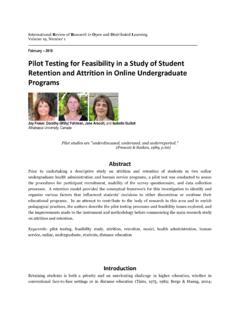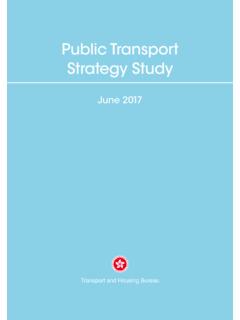Transcription of 9 Steps to Conducting a Feasibility Study
1 Page 1 Inside our TRIBE PLATFORM, every endeavor, such as curating an art show, requires a tribe wherein you do three things - segment into groups, accomplish a set of tasks, and report those tasks back to the tribe. After reading this document, return back to and click the register link (in the footer) to begin using our BEST control panel to manage your tribe efficiently. Starting a tribe in our system is free for 30 days. 9 Steps to Conducting a Feasibility Study A Feasibility Study looks at the viability of a business venture or project with an emphasis on identifying potential problems. The Study attempts to answer two main questions: Will the proposed business venture or project work, and should you proceed with it? There are Feasibility studies applied to the business as a whole and to various composites of a business or project. For instance, all businesses can critically examine the actions they take, whether the business is just starting out or has been in operation for a while.
2 Establishing the viability of an idea or action can ultimately determine whether a business succeeds or not. The best tool for determining this is by Conducting a Feasibility Study . The initial designing stage of a task or a project that brings together all the elements of knowledge and estimate the level of expertise needed for it is conducted via a Feasibility Study . It also offers a quantitative and qualitative assessment of other vital resources, timetable, cost estimate, and identification of critical points. This information is extracted and combined from different resources including: Page 2 Step 1: Study your Feasibility Study While Feasibility studies are typically conducted by business organizations, other organizations can naturally benefit from it as well. Since the Study aims to discover whether an action is viable, it can help organizations to avoid costly or operationally exhausting ventures. When should a Feasibility Study be used?
3 The Study is typically used in situations where an important strategic decision needs to be taken. This can vary and some of the example situations include: Change in business location Purchase of new equipment or software Acquisition of another company Hiring of additional employees Why are Feasibility Studies So Important? The information you gather and present in your Feasibility Study will help you identify all the things you need to make the business work, pinpoint logistical and other business-related problems and solutions, develop marketing strategies to convince a bank or investor that your business is worth investing in, and serve as a solid foundation for developing a plan for startup. Image from Page 3 What are some Types or Forms of a Feasibility Study ? #1 Technical Feasibility The first element deals with technical Feasibility of the proposed action plan. If your organization is introducing a new product or a service, the technical Feasibility Study will determine if it s a technically viable action.
4 Secondly, the technical Feasibility assessment is about the outline design and the ability to handle the technical expertise of the project. It measures the particular technical solution and then files its report giving details of: The economic and human factor Possible solutions to the problems The specific part of a problem that is being evaluated Brief description of the problem or its composites for more assessment. Thirdly, this part of the Feasibility Study should answer the following questions: What is the proposed product or service? Is the product or service already on sale? If not, how far is it from an existing marketplace and what will the introduction cost? How can you protect the product or service from the competition? What are the strengths of the product or service? What are the main benefits to customers or users? What resources are required for producing or providing it? How capable is the organization to acquire these resources?
5 What are the regulatory standards surrounding the product or service and its use? Remember the above questions can be used when you are introducing a new product or launching a business, but also if you are implementing a new product or service within your organization. For instance, if you are introducing new software, you must understand the strengths of it, as well as the resources required for implementing it. Page 4 #2 Legal Feasibility The Feasibility Study determines whether the proposed system conflicts with legal requirements and ethical considerations or not. #3 Time Feasibility A time Feasibility Study takes into account the period needed to complete the project. It is a measure of the reasonability of a project and thus determines whether the deadline is desirable or mandatory or not. #4 Resource Feasibility A resource Feasibility Study measures whether you have required resources and the facilities to build and complete the new project and whether it will interfere with the present business operations.
6 #5 Operational Feasibility The operational Feasibility Study determines how the proposed system will solve any problem and take advantage of the identified opportunities. Page 5 It puts its focus on how the proposed development fits with the objectives and environment of the business regarding existing processes, corporate culture, delivery date, and development schedule. #6 Financial Feasibility The second element focuses on testing the market for the proposed action or idea. It examines issues like whether the product or service can be sold at reasonable prices or if there s a marketplace for it. Market Feasibility should answer the following questions: What market segments are you targeting? Why would people buy the product or service? Who are the potential customers and how many of them are there? What are the buying patterns of these potential customers? How will you sell the product or service? Where? Who are your competitors?
7 Including past, current and future competitors. What are the strengths and weaknesses of your competitors? What is your product or service s competitive edge? The above essentially points out to the importance of Conducting market research as part of your Feasibility Study . Market Feasibility is an important part of a Feasibility Study when the plan of action deals with issues such as business expansion, new product or service launch, product development and starting up a business. Page 6 #7 Commercial Feasibility Commercial Feasibility is an element of the Study focused on the probability of commercial success. It s mainly focused on studying the new business or a new product or service, and whether your organization can create enough profit with it. The questions that require answering as part of the commercial Feasibility Study include: What are the strengths and weaknesses of your business? What are the potential sales volumes of the product or service?
8 What is the pricing structure you ll use? What are the sensitivity points for your business in terms of sales? What is the ROI? Furthermore, if you are Conducting a Feasibility Study as part of launching a business or project or several of their composites, you also need to answer the following questions: How long can your business survive without a sale? How long before you break even with the product or service? How much money is required to start operating? Will your organization require external finance? Is this plan technically feasible? Is this plan legal? Is this plan operationally feasible? Is this plan feasible within a reasonable period of time? Is this plan economically feasible? While the above points are mainly important for new businesses, any organization can benefit from thinking about them when launching a new operation. For example, if you are adding a new product line to your business, you should use the above questions as a guide to understanding the implications to your other operations and the financial viability of the new product.
9 Page 7 Step 2: Conduct preliminary analysis Begin by outlining your plan. You should focus on an unserved need, a market where the demand is greater than the supply, and whether the product or service has a distinct advantage. Then you need to determine if the hurdles are too high to clear. A Feasibility Study can be a time-consuming process and it doesn t come without its costs. It s therefore auspicious to start by Conducting preliminary analysis. This is essentially a pre-screening of the proposed action and it examines whether a proper Feasibility assessment is worth the time and money. For example, before you conduct a Feasibility Study on the viability of acquiring a business, you want to check quickly the overall attainability of the action. If the acquisition is so risky that it could bankrupt your business, there s no reason for Conducting a proper Feasibility Study . Preliminary assessment should consist of the following Steps : First, you want to outline the planned idea or action.
10 This means looking at what you are looking to achieve and why. Second, you should examine the market space and the commercial viability of the action. You want to get an overall feel of what type of customers are you potentially attracting. Third, you should examine the unique characteristics of the idea and whether they are strength or a weakness. The idea or action might have certain unique characteristics ( location, price, usability) and these might help your organization. Fourth, you need to determine if there are insurmountable risks to the action. It s essential to outline any risks that could possibly reduce the viability of the action or idea close to zero. Keep in mind the above is just to get an overall feel of the idea. You don t need to conduct full market research at this point, but simply understand whether there s any kind of space for the action within the market. If your preliminary analysis doesn t find any insurmountable obstacles and the commercial viability is possibly there, you can continue with the proper Feasibility Study .



